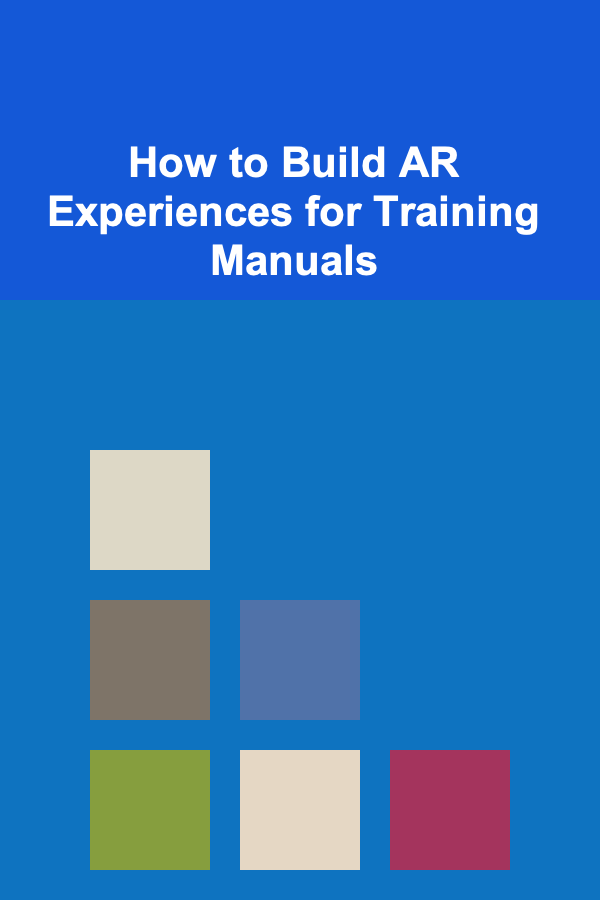
How to Build AR Experiences for Training Manuals
ebook include PDF & Audio bundle (Micro Guide)
$12.99$8.99
Limited Time Offer! Order within the next:

Augmented Reality (AR) is rapidly transforming the way industries approach training, making learning more engaging and interactive. By superimposing digital content onto the real world, AR can enhance the way users interact with training manuals, turning static documents into dynamic and immersive experiences. AR not only makes training more engaging but also improves retention and provides an interactive hands-on experience that traditional manuals cannot offer. In this article, we will explore how to build AR experiences for training manuals, discussing the steps, tools, technologies, and best practices involved.
Understanding Augmented Reality in Training
Before diving into the process of building AR experiences, it's essential to understand what AR is and how it benefits training programs.
What is Augmented Reality (AR)?
Augmented Reality is a technology that overlays digital content---such as images, videos, sounds, or 3D models---onto the real world in real-time. Unlike Virtual Reality (VR), which immerses users in a completely virtual environment, AR enhances the physical world by blending it with virtual elements. This technology can be accessed through smartphones, tablets, AR glasses, and headsets.
The Benefits of AR for Training
- Enhanced Engagement: AR transforms passive reading into an interactive experience, helping users engage with content more effectively.
- Increased Retention: Studies show that learners retain information better when they are actively involved in the learning process. AR provides a more hands-on and visual approach, making it easier for users to remember concepts.
- Real-World Application: AR allows users to interact with virtual content in real-world settings, making training more relevant and applicable to their everyday tasks.
- Instant Feedback: With AR, users can receive real-time feedback during training, allowing them to learn from mistakes and correct them immediately.
- Flexibility and Accessibility: AR training manuals can be accessed on a variety of devices, offering flexibility in how and when training is conducted.
Steps to Building AR Experiences for Training Manuals
Creating AR experiences for training manuals involves several key steps, from conceptualization to implementation. Here's a detailed breakdown of how to build an AR-enhanced training manual:
Step 1: Define the Training Objectives and Content
The first step in building an AR training manual is to clearly define the training objectives and the content that will be covered. Understanding the goals of the training is crucial for designing AR experiences that align with learning outcomes.
Key Considerations:
- Audience: Determine who will be using the training manual. Is it for new employees, existing staff, or customers? Understanding your audience will help tailor the content and AR experience to their needs.
- Learning Objectives: Identify the key skills or knowledge that the training should impart. This could include operational procedures, safety protocols, or troubleshooting steps.
- Content Type: Decide what kind of content will be integrated into the training manual. This could include text, images, videos, animations, 3D models, or interactive simulations.
Step 2: Choose the Right AR Platform and Tools
Building AR experiences requires selecting the appropriate software tools and platforms. There are many AR development platforms available that can help you create, manage, and deploy AR content for training manuals.
Popular AR Development Platforms:
- Vuforia: A leading AR platform that supports a wide range of devices and offers features like image recognition, 3D model integration, and cloud-based services.
- ARKit (iOS) and ARCore (Android): These are the native AR development platforms for iOS and Android devices, respectively. They offer robust AR capabilities like object recognition and scene understanding.
- Unity: Unity is a popular game engine that also supports AR development. It can be used in conjunction with ARKit or ARCore to build highly interactive AR experiences.
- ZapWorks: A web-based AR platform that allows users to create AR experiences for mobile devices. It's ideal for simple AR applications like interactive training manuals.
- Blippar: A platform focused on delivering AR experiences through smartphone apps. It allows for object recognition, gamification, and user interaction.
Considerations:
- Device Compatibility: Make sure the platform you choose is compatible with the devices that will be used for training (smartphones, tablets, AR glasses, etc.).
- Ease of Use: Choose a platform that aligns with your development skills. Some platforms are more user-friendly and do not require advanced coding knowledge.
- Features: Consider the features you need, such as image recognition, geolocation, 3D models, or gamification elements. Choose a platform that offers the necessary tools for these features.
Step 3: Create Interactive Content
Once you've defined your training content and chosen the AR development platform, the next step is to create the interactive content that will be used in the AR training manual. The content needs to be engaging and aligned with the learning objectives.
Types of Interactive Content for AR Manuals:
- 3D Models: Use 3D models to represent complex objects or machinery. For example, in an engineering training manual, users can interact with a 3D model of a machine to see how it works from different angles.
- Animations: Create animations that demonstrate processes, such as assembly steps, equipment operation, or troubleshooting procedures.
- Videos: Incorporate video clips that provide step-by-step instructions or simulations. These can be triggered by scanning images or QR codes in the manual.
- Interactive Simulations: Design simulations that allow users to practice tasks in a controlled virtual environment. This could be particularly useful in high-risk industries like healthcare or aviation.
- Quizzes and Assessments: Include quizzes or knowledge checks to assess the user's understanding and reinforce key concepts.
Step 4: Integrate AR Content with the Manual
The next step is to integrate the AR content into the training manual itself. This involves adding triggers (such as images or markers) that will activate the AR experiences when scanned by the user's device.
Trigger Methods:
- Image Recognition: The most common method of triggering AR experiences. Specific images or graphics in the manual will act as markers that the AR app recognizes and uses to display the corresponding digital content.
- QR Codes: QR codes can be placed within the training manual to link to specific AR content. When scanned, they will redirect the user to a website or app with the relevant AR experience.
- Geolocation: In some cases, the training manual may include location-based content. For example, a maintenance manual might provide AR guidance based on the user's current location within a factory or facility.
Step 5: Develop the AR App or Solution
If you are developing a custom AR solution, you will need to build the app or software that users will interact with. This could be a standalone AR app or an extension of an existing app (such as a company's learning management system).
Key Features to Include:
- User Interface (UI): The app should have an intuitive interface that allows users to easily navigate between the training manual pages and AR experiences.
- Real-Time Interactions: Ensure that users can interact with the AR content in real-time, such as rotating 3D models, zooming in on objects, or interacting with buttons.
- Tracking and Calibration: Implement tracking systems that ensure the AR content stays anchored to the real world as the user moves their device around.
- Feedback Mechanisms: Include feedback mechanisms like visual cues or audio prompts to guide users through the training process and ensure they are following the correct procedures.
Step 6: Test and Optimize
Before launching your AR training manual, it's crucial to test the content thoroughly to ensure that it works as intended. Testing should be done on a variety of devices to ensure compatibility and a seamless user experience.
Testing Considerations:
- Device Compatibility: Test the AR experiences on different devices (smartphones, tablets, AR glasses) to ensure that the content is displayed correctly across all platforms.
- User Experience: Conduct usability testing with a small group of users to identify any navigation issues or user confusion. Collect feedback and make improvements based on the results.
- Performance Optimization: AR content can be resource-intensive, so it's important to optimize the app's performance to ensure smooth operation without lag or crashes.
Step 7: Deploy and Monitor
After testing and refining the AR training manual, you can deploy it to your users. Depending on your platform, this could involve publishing the AR app to the App Store or Google Play, or providing access via a private link or QR code.
Post-Launch Monitoring:
- Usage Analytics: Use analytics tools to track how users are interacting with the AR content. This will help you identify any areas where users are struggling or losing interest.
- Feedback Collection: Continuously gather user feedback to improve the AR experience. You can use surveys or in-app feedback mechanisms to gather insights.
- Content Updates: Keep the content up-to-date by regularly adding new features, updating training materials, and refining the AR experience based on user needs.
Best Practices for Building AR Experiences
To create a successful AR training manual, consider these best practices:
- Keep the User in Mind: Ensure that the AR experience is intuitive, easy to navigate, and aligned with the user's learning goals.
- Blend Virtual and Real Worlds: AR is most effective when it enhances the real-world experience. Avoid overwhelming users with too much virtual content---ensure that it complements the physical world.
- Provide Clear Instructions: Since AR is still a relatively new technology for many users, provide clear instructions on how to interact with the AR content and what to expect.
- Focus on Quality: High-quality 3D models, animations, and videos are essential for creating an immersive and professional training experience. Poorly designed content can detract from the learning experience.
- Iterate Based on Feedback: Continuously improve the AR experience based on user feedback. This will help ensure that the training manual remains effective and relevant over time.
Conclusion
Building AR experiences for training manuals is a powerful way to enhance learning, improve engagement, and ensure better retention of information. By following the steps outlined in this article and leveraging the right tools and platforms, you can create immersive, interactive training manuals that elevate the learning experience for your audience. As AR technology continues to evolve, the possibilities for creating engaging training experiences will only grow, opening new doors for industries seeking innovative ways to educate and train their workforce.
Reading More From Our Other Websites
- [Organization Tip 101] How to Manage Multiple Sellers at a Community Yard Sale
- [Gardening 101] How to Build a Strong and Durable Garden Fence
- [Personal Care Tips 101] How to Store Your Razor for Longevity and Optimal Performance
- [Home Space Saving 101] How to Maximize Vertical Space in Small Apartments
- [Digital Decluttering Tip 101] How to Build a Foolproof Backup System for Your Digital Photo Library
- [Personal Investment 101] How to Create a Budget for Investing: Maximizing Your Returns
- [Gardening 101] Seasonal Fertilizer Calendar: When and How to Feed Your Garden Year‑Round
- [Mindful Eating Tip 101] Rooted in Presence: Plant-Based Lunches for Mindful Eating
- [Personal Finance Management 101] How to Build a Solid Credit History Without Getting Into Debt
- [Soap Making Tip 101] Best Seasonal Soap Collections: From Spring Florals to Autumn Spice

Efficient Task Management for Busy Dads
Read More
Sales: Techniques for Selling Anything to Anyone
Read More
How To Shoot Training and Educational Videos
Read More
Maintaining Your Hydration Pack Cleaning Kit: A Comprehensive Guide
Read More
10 Tips for Remote Healthcare Administration Success
Read More10 Tips for Maximizing Your Vision Insurance Benefits & Tracking Expenses
Read MoreOther Products

Efficient Task Management for Busy Dads
Read More
Sales: Techniques for Selling Anything to Anyone
Read More
How To Shoot Training and Educational Videos
Read More
Maintaining Your Hydration Pack Cleaning Kit: A Comprehensive Guide
Read More